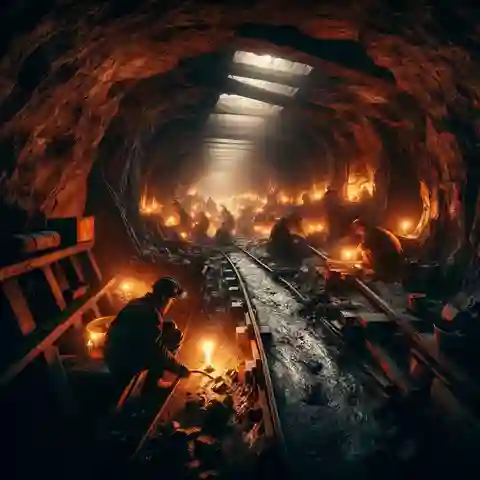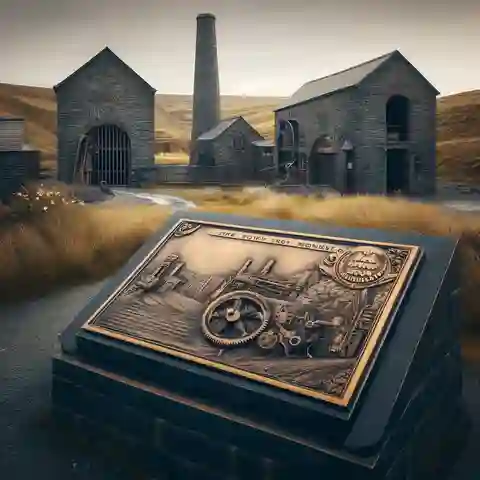The Levant mining disaster – The rugged coastline of Cornwall, in southwest England, hides a rich history etched deep beneath the earth. For centuries, tin mining fueled the region, drawing men into the depths in search of precious ore.
The Levant Mine, clinging precariously to cliffs above the Atlantic Ocean, was one such place where fortunes were sought, and lives were sometimes lost. But nothing could prepare the close-knit community for the disaster that struck on October 20th, 1919.
Setting the Scene – Life and Work at Levant Mine

- A World of Darkness and Danger: Imagine working hundreds of feet below the earth, in tunnels barely tall enough to stand in. The air is thick with dust, hot and humid. The only light comes from your flickering candle, and the constant clang of tools on rock rings in your ears. This was the reality for miners at Levant.
- The Man Engine: A Lifeline and a Risk: The Man Engine was meant to ease the grueling climb out of the mine. It was like a giant, slow-moving ladder with small platforms. Miners would step on, ride a short distance, then step off as the whole contraption moved. While safer than climbing, it was old technology and carried its own dangers.
- Miners: A Community Forged in Hardship: Mining wasn’t just a job; it was a way of life. Generations of families worked at Levant. Men shared a bond born of hardship and constant risk. They knew each day could be their last.
The Day Disaster Struck – October 20th, 1919
- Routine Turned to Horror: The morning of October 20th began like any other. Miners joked as they descended on the Man Engine, unaware of the horror awaiting them. Suddenly, a sharp crack echoed through the shaft – a vital metal part had snapped.
- Cascading Chaos: The failure wasn’t just a breakdown; it was a chain reaction. Heavy wooden beams, platforms, and debris hurtled downwards, crushing everything in their path. Men screamed as their only way out became a death trap.
- Frantic Rescue: Topside, the unthinkable became real. Desperate families rushed to the mine. Rescue teams, knowing the risks, descended into the wreckage.
- The Grim Toll: 31 miners died in the Levant Mining Disaster. In a small community, the impact was staggering. Sons, fathers, brothers, and friends were gone. Injuries were severe, and the psychological scars ran deep.
Note: This section aims to be informative but also to create an emotional impact. The contrast between the daily routine and the suddenness of the disaster is a powerful element of the story.
Levant Mining Disaster Rescue and Recovery

News of the disaster sent shockwaves through Cornwall. Rescue teams from other mines, risking their own lives, rushed to the scene. What they faced was a nightmare:
- Chaos Underground: The shaft where the Man Engine collapsed was choked with debris – timbers, rocks, twisted metal. This blockage made reaching potential survivors incredibly difficult.
- Deadly Hazards: The collapse made other parts of the mine unstable. Rescuers worked under the constant threat of further cave-ins, gas leaks, or flooding. Every step was a gamble.
- Bravery and Determination: Despite the danger, rescuers worked tirelessly, digging with picks and shovels where machines couldn’t go. They were driven by the slimmest hope of finding someone alive amidst the devastation.
- Fading Hope, Grim Reality: As hours turned into days, hope dwindled. The focus shifted from miraculous rescue to the grim task of recovery. It was heartbreaking work, bringing lost friends and neighbors back to the surface.
Investigation and the Search for Answers
In the aftermath, the community demanded answers. How could this have happened?
- Official Inquest: A formal investigation was launched to find the cause of the Man Engine’s failure. Experts examined the wreckage, interviewed witnesses, and tried to piece together what went wrong.
- The Burning Questions: Was it a faulty part? Had maintenance been neglected? Or was this simply one of the terrible but unavoidable risks of mining?
- Seeking Change: The Levant Mining disaster put a spotlight on mine safety. Questions were raised about whether regulations were strict enough and if technology could be improved to prevent future tragedies. The hope was that lessons learned from this loss could save lives elsewhere.
The Disaster’s Long Shadow

The Levant Mining Disaster didn’t just hurt that day, it left a mark that lasted for years. Here’s how it changed lives and Cornwall itself:
- Families Struggling: Cornwall was already a poor area. When those miners died, their families lost the money they needed to survive. This made a bad situation much worse. It showed how dangerous it was to rely on just one kind of job.
- A Whole Town Grieving: These mining towns were small, everyone knew everyone. Almost every family lost someone or knew someone who did. The sadness was everywhere, and it lasted for generations. People were hurting both in their hearts and their wallets.
- Remembering the Miners: Cornwall never forgot what happened. They built memorials and hold ceremonies every year to remember the men who died. This is to honor them, but also to teach younger people about the past.
- Was This the End for Mining? The disaster made people realize just how dangerous mining could be. It wasn’t the only reason, but it happened at a time when Cornish mining was already in trouble. Things were running out, cheaper tin came from other countries, and World War I messed things up. The disaster made people even less hopeful about the future of mining.
The Legacy
The Levant Mine closed, and most tin mining in Cornwall faded away. But the disaster’s story is still told.
Echoes of the Past – The Levant Mine Today
Though the days of active mining at Levant are over, the site hasn’t been abandoned to the whispers of the wind. Instead, it has become a place where the past speaks to the present.
- Preservation Efforts: The importance of the Levant Mine isn’t lost. It’s been recognized as a historical landmark, meaning there are efforts to protect the old buildings, the iconic engine houses, and what’s left of the underground workings. This ensures the physical reminders of the mine won’t disappear.
- Tourism and Education: The mine isn’t just a ruin; it’s a classroom. Visitors can tour parts of the site, getting a feel for what the miners’ world was like. There are exhibits explaining how things worked, the history of the area, and, importantly, stories of the men who worked there. This keeps Cornish mining history alive for new generations.
- Reflecting on Lives Lost and Lessons Learned: Visiting Levant is more than just a history lesson. It’s a place to remember those 31 miners and think about the dangers faced by workers throughout history. The disaster reminds us about the importance of safety and how things we do today might have consequences we never expect.
There’s something special about standing where history happened. The Levant Mine, with its weathered ruins and the roar of the Atlantic in the distance, holds a unique power.
It’s a testament to the past, a place to learn, and a solemn reminder of the sacrifices made in the pursuit of progress.
Conclusion
Though decades have passed, the memory of the Levant Mining Disaster remains etched in Cornwall’s collective consciousness. It’s a tale of resilience, sacrifice, and the unbreakable bonds forged in the face of adversity. And as the echoes of the miners’ toil fade, the lessons of their tragic day must not be forgotten.



